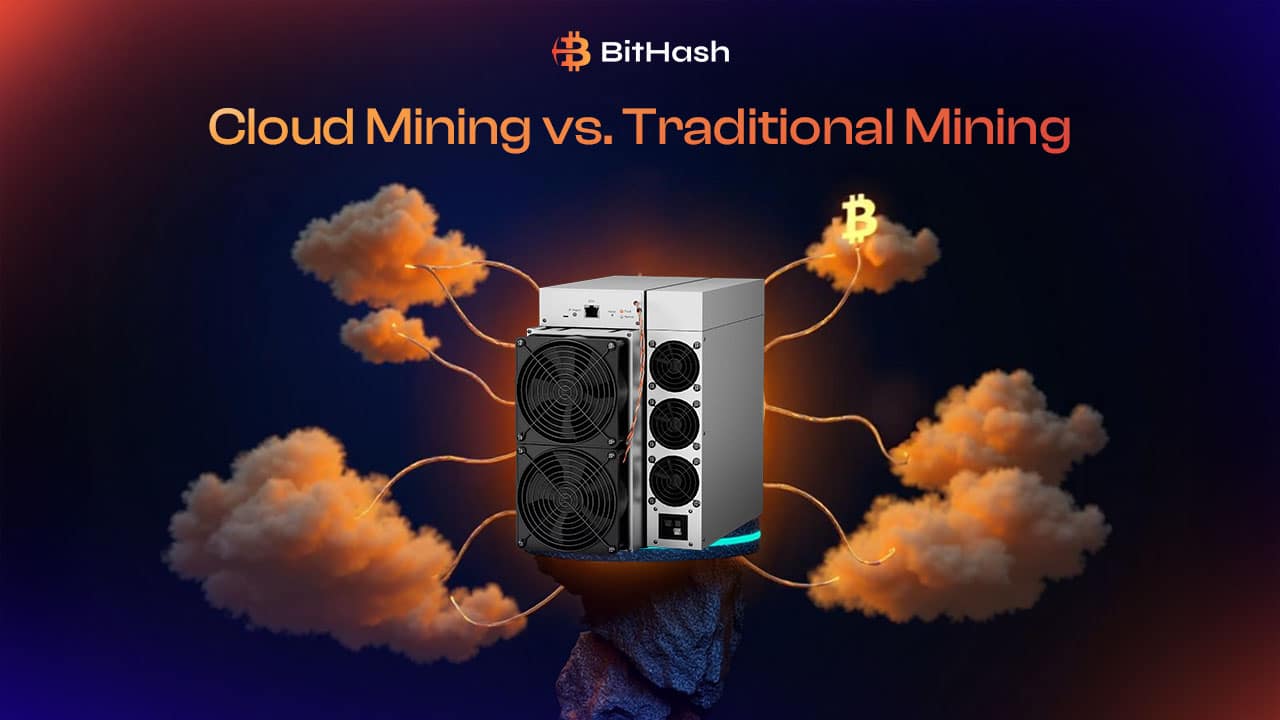
Cryptocurrency mining remains a popular way to earn digital assets, but the landscape has evolved significantly. In 2025, miners must choose between traditional mining (self-operated rigs) and cloud mining (rented hash power). Both have pros and cons, but which one is more profitable?
This in-depth guide compares costs, risks, profitability, and future trends to help you decide the best mining strategy for 2025.
1. Understanding Cloud Mining and Traditional Mining
Here’s a quick look into how these two mining approaches differ in setup, profitability, and accessibility within the evolving cryptocurrency landscape.
What is Traditional Mining?
Traditional bitcoin mining refers to the process of validating transactions and securing the blockchain using one’s own mining hardware. This typically involves high-performance devices like ASICs (Application-Specific Integrated Circuits) or powerful GPUs (Graphics Processing Units). These systems work around the clock to solve complex mathematical puzzles, and in return, miners receive a mining reward in the form of newly minted bitcoin.
Key Features of Traditional Mining:
Full Control Over Mining Hardware and Operations Miners have complete authority over how their equipment operates. From selecting the mining hardware to choosing the mining pool and optimizing cooling systems, control lies entirely in the hands of the operator.
Higher Profit Potential with Efficient Management If well-maintained and strategically operated, traditional setups can yield greater profits than other mining methods. This is particularly true during bullish market phases when the mining reward increases in value.
High Initial Investment Setting up a traditional mining rig requires a significant upfront investment. Costs include not only the mining hardware, such as ASICs or high-end GPUs, but also expenses for electricity, ventilation, and cooling solutions.
Requires Technical Knowledge and Constant Upkeep Managing a mining setup isn’t just plug-and-play. It requires consistent monitoring, troubleshooting, and an understanding of how blockchain networks and mining algorithms operate.
Alternative Option: Cloud Mining Platforms
For those who want to participate in bitcoin mining without the technical hassle, cloud mining platforms offer an alternative. These services allow users to purchase a mining contract—a pre-defined agreement that entitles them to a share of the mining output without owning the hardware directly. While this reduces operational burden, it also means less control and, sometimes, lower returns depending on the provider.
Whether you opt for traditional setups or cloud mining platforms, understanding the mechanics of bitcoin mining, the types of mining hardware, the terms of a mining contract, and how mining rewards are distributed is essential to making informed decisions in this evolving crypto landscape.
Pros and Cons of Traditional Mining
| Pros | Cons |
| Full control over hardware | High upfront costs (GPUs, ASICs, etc.) |
| Can mine multiple cryptocurrencies | Noisy, hot, and space-consuming |
| Asset ownership (can sell hardware) | Maintenance & hardware failures |
| Potential for higher profits | High electricity & cooling expenses |
What is Cloud Mining?
Cloud mining is a modern, hands-off method of crypto mining that enables individuals to participate in blockchain validation without the hassle of owning physical mining equipment. Instead of setting up rigs or purchasing expensive ASIC miners, users simply rent computational power, also known as hash rate, from large-scale data centers through a cloud mining contract.
These data centers, often located in regions with cheap electricity or access to renewable energy sources, operate massive mining equipment farms. Users pay for a portion of this infrastructure’s output and receive a share of the profits based on the hash rate they’ve rented.
Key Features of Cloud Mining
No Hardware or Electricity Maintenance Cloud mining completely eliminates the need to purchase, install, and maintain any physical ASIC miners or other mining equipment. This means no worries about electricity costs, heat dissipation, or hardware failures.
Low Barrier to Entry Thanks to flexible cloud mining contract options, individuals can start crypto mining with minimal capital. There’s no need to invest in costly infrastructure, just choose a plan, pay the fee, and you’re good to go.
Limited Control Over Operations Users have little to no influence over the actual mining operations, including software configuration or how computational power is allocated. Trusting the cloud mining provider becomes essential.
Potential for Scams or Unreliable Providers The space is rife with fraudulent or unregulated platforms. Choosing a reputable service is vital to avoid losing your investment and ensure consistent mining payouts.
Whether you’re a newcomer dipping your toes into crypto mining, or a seasoned investor looking for passive income with a sustainable angle, cloud mining offers flexibility and ease, just be sure to vet those cloud mining platforms thoroughly.
Pros and Cons of Cloud Mining
| Pros | Cons |
| No hardware or electricity costs | Lower profits (fees cut into earnings) |
| Easy to start (no setup needed) | Risk of scams (fake cloud mining services) |
| Accessible from anywhere | Less control (dependent on provider) |
| Scalable (buy more hash power) | Potential shutdowns (provider may exit) |
2. Profitability Comparison in 2025
In 2025, cloud mining continues to offer a more accessible entry point compared to traditional setups, with companies like Genesis Miners providing flexible mining plans that eliminate the need for upfront hardware costs. Unlike traditional CPU mining or solo mining, which often involve high power consumption and require managing your own gear, cloud contracts bundle operational expenses and boost energy efficiency by leveraging optimized infrastructure.
While traditional mining using ASIC miners still offers high rewards, the significant energy consumption and overhead make cloud mining attractive for those focused on lower risk and cost-effective returns.
A. Upfront Costs
| Factor | Traditional Mining | Cloud Mining |
| Hardware Cost | $3,000 – $10,000 (ASIC/GPU) | $0 (renting hash power) |
| Electricity | $100 – $500/month | Included in contract |
| Maintenance | Cooling, repairs, upgrades | None |
| Entry Cost | High ($5k+) | Low ($100+) |
Winner: Cloud mining (lower initial investment)
B. Ongoing Expenses
Traditional mining involves managing your own mining machines, such as high-powered units like the Antminer S21, which offer impressive processing capabilities but demand substantial electricity and cooling systems. As electricity prices fluctuate globally, these operational costs can dramatically impact overall profitability, especially when combined with ongoing maintenance and regular updates to mining software. On the other hand, cloud mining provides a more predictable cost structure through fixed-fee contracts.
However, some providers may include hidden charges like additional service fees or deductions from transaction fees, which can reduce the miner’s share of rewards. Both models are sensitive to movements in the cryptocurrency market, where the value of mined coins and network difficulty heavily influence returns.
Winner: Depends on electricity costs in your region.
C. Profit Margins
- Traditional Mining: Offers potentially higher profits, especially when electricity is affordable, mining hardware like ASIC miners (e.g., Antminer S21) is energy-efficient, and the cryptocurrency market is favorable. However, profitability can be quickly reduced by high energy consumption, maintenance needs, and unpredictable electricity prices.
- Cloud Mining: Generally yields lower profits due to service fees, limited control, and potential cuts from transaction fees. Yet, it provides more predictable earnings with minimal setup, making it ideal for passive investors or those avoiding the complexity of managing mining machines and mining software.
Example (Bitcoin Mining in 2025):
| Metric | Traditional Mining | Cloud Mining |
| Hash Power | 100 TH/s (own ASIC) | 100 TH/s (rented) |
| Daily Revenue | $30 | $25 (after fees) |
| Monthly Costs | $400 (electricity + maintenance) | $0 (prepaid contract) |
| Net Profit | $500/month | $750/month
(if no hidden fees) |
Assumptions: BTC price $70,000, mining difficulty increasing moderately.
Winner: Cloud mining can be better for small miners; traditional mining scales better for large operations.
3. Risks & Challenges
Before choosing a mining strategy, it’s crucial to understand the specific risks associated with each approach:
-
Traditional Mining Risks
One of the major risks in traditional bitcoin mining is hardware obsolescence—ASIC miners and other devices often become outdated quickly as newer, more efficient models are released, reducing performance and profitability over time.
Additionally, regulatory pressure is a growing concern, as many regions are imposing strict rules or outright bans on mining activities due to concerns over excessive energy consumption and environmental impact, potentially limiting operations or forcing relocation.
-
Cloud Mining Risks
Scams and fraud are common concerns in cloud mining, as many platforms lack transparency or proper regulation, making it difficult to verify their legitimacy.
Additionally, miners face limited control over operations, meaning sudden shutdowns or reduced payouts can occur—potentially leading to significant financial losses without warning or recourse.
Winner: Traditional mining is riskier but more transparent.
4. Future Trends Impacting Mining in 2025
The 2024 Bitcoin halving event, which reduced block rewards from 6.25 BTC to 3.125 BTC, has significantly tightened miner profit margins, unless bolstered by a rising Bitcoin price. As energy costs surge, renewable energy mining farms are emerging as the new standard for sustainability and long-term viability.
Meanwhile, evolving regulations are nudging miners toward more compliant and efficient setups like cloud mining platforms. Interestingly, some mining providers are now leveraging AI technology to optimize hash power allocation, paving the way for smarter, more adaptive mining operations.
This technological shift could also improve uptime, reduce energy waste, and enhance overall mining profitability in a volatile market shaped by rapid innovation and increasing global scrutiny.
5. Final Verdict: Which is More Profitable in 2025?
| Scenario | Best Choice |
| Low budget, no technical skills | Cloud Mining |
| Access to cheap electricity | Traditional Mining |
| Long-term, large-scale mining | Traditional Mining |
| Short-term, passive income | Cloud Mining (if trusted provider) |
Conclusion:
In the evolving landscape of crypto mining, both approaches offer unique advantages:
- Cloud mining is ideal for beginners or those seeking passive income with minimal effort and lower upfront risks. It removes the need for managing mining equipment, making it accessible and hassle-free.
- Traditional mining remains the go-to for large-scale miners who have access to affordable electricity and can optimize energy efficiency with cutting-edge ASIC miners like the Antminer S21.
Regardless of your path, it’s essential to calculate ROI using trusted mining calculators and thoroughly research providers—whether you’re reviewing cloud mining contracts or sourcing reliable hardware. A smart investment starts with sharp insight.



